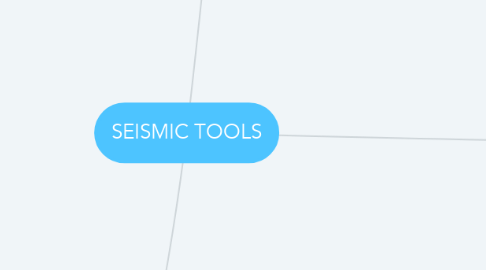
1. seismic detectors
1.1. land detectors
1.1.1. geophones
1.1.1.1. - measure a single component (vertical)
1.1.1.2. - common design is moving coil geophones
1.1.1.3. PROCESS
1.1.1.3.1. 1) a cylindrical coil is suspended vertically from a spring support
1.1.1.3.2. 2) it is surrounded by a permanent magnet, which is attached to the instrument casing
1.1.1.3.3. 3) instrument casing, usually plastic, which has a long spike for anchoring the geophone to the ground
1.1.1.3.4. 4) Vertical motion of the ground causes the instrument and magnet to move up and down, while the coil is stationary
1.1.1.3.5. 5) This produces an electric voltage through the coil, which is recorded as an electric signal
1.1.1.3.6. 6) The unit is calibrated so that the voltage is proportional to the velocity of the coil
1.1.2. seismometers
1.1.2.1. - similar to geophones, but they are installed in permanent housings (vaults)
1.1.2.2. - mostly for earthquake monitoring
1.1.2.3. - both one and three-component seismometers exist, and they can be tuned to record within certain frequency bands
1.2. marine detectors
1.2.1. hydrophones
1.2.1.1. - detect a change in pressure in the water and piezoelectric elements -> electrical signal
1.2.1.2. - produces small electrical charges when exposed to pressure changes
1.2.1.3. - electrical signals is analyzed with computer programs
1.2.1.4. - usually towed behind a boat in a streamer
1.2.1.5. PROCESS
1.2.1.5.1. 1) Streamer lengths can exceed 5 km, and it is common to tow multiple streamers in parallel, to obtain 3D coverage
1.2.1.5.2. 2) Pressure sensors, compasses and tail buoys are used to monitor the position of the streamer
1.2.1.5.3. 3) fins / bird are used as steering device controlling streamer separation and position
1.2.2. Ocean-bottom Seismometers (OBS)
1.2.2.1. - similar to land seismometers, but are housed in an airtight, metal container that is lowered overboard and sinks to the seafloor
1.2.2.2. - OBS’s can contain three-component seismometers, enabling the recording of the full 3D motion of the seafloor
1.2.2.3. - difficult to position them, and OBS have short lives due to limited battery power and limited disk drive space
2. seismic recorders
2.1. analog
2.1.1. - limitation : depend on capability of recording devices
2.1.2. - strip chart recorder
2.1.3. - magnetic tape
2.2. digital
2.2.1. - analog to digital converter
2.2.2. - sampling the signal at discrete intervals (in ms)
2.2.3. - represent amplitude by a signed number
2.3. IMPORTANT CONSIDERATIONS
2.3.1. Sampling rate
2.3.2. Sampling frequency
2.3.3. Trace length
2.3.4. Nyquist frequency (aliasing)
2.4. CHARACTERISTICS
2.4.1. - fast
2.4.2. - portable
2.4.3. - easy to use
3. seismic sources
3.1. land sources
3.1.1. weight drops (shallow investigation)
3.1.1.1. - known as impacted source
3.1.1.2. - uses sledgehammer/ 75kg load drop
3.1.1.3. ADVANTAGE
3.1.1.3.1. 1) cheap
3.1.1.3.2. 2) simple to operate
3.1.1.4. DISADVANTAGE
3.1.1.4.1. 1) difficulty to sustain the power of impact from one source point to another source point
3.1.1.4.2. 2) low frequency
3.1.1.4.3. 3) surface wave > body wave
3.1.2. explosive (shallow investigation)
3.1.2.1. - dynamite
3.1.2.2. - best used at unconsolidated/ weathered area
3.1.2.3. - improves coupling to solid ground and reduces surface damage
3.1.2.4. - shotgun < dynamite (shotgun is less effective)
3.1.2.5. ADVANTAGE
3.1.2.5.1. 1) provide good P-wave
3.1.2.5.2. 2) high resolution in seismic image
3.1.2.6. DISADVANTAGE
3.1.2.6.1. 1) mobilization is slow
3.1.2.6.2. 2) impact is different at different source
3.1.3. vibratory (deeper investigation)
3.1.3.1. - known as vibroseis
3.1.3.2. - tractor mounted vibrator to pass into ground and extended vibration of low amplitude
3.1.3.3. - large mass in contact with ground (specific pattern)
3.1.3.4. - 10-18 Hz
3.1.3.5. - generate P-wave and S-wave
3.1.3.6. ADVANTAGE
3.1.3.6.1. 1) repeatable
3.1.3.6.2. 2) signal is well defined
3.1.3.6.3. 3) can produce S-wave
3.1.3.7. DISADVANTAGE
3.1.3.7.1. 1) signal cant be directly interpreted
3.1.3.7.2. 2) required professional computer processing
3.1.3.7.3. 3) needs hard surface
3.1.3.7.4. 4) high cost (truck)
3.2. marine sources
3.2.1. air guns
3.2.1.1. - air guns > dynamite at swamp/ marsh area (dynamite is difficult to position & blasting)
3.2.1.2. - pneumatic source
3.2.1.3. - air is released through electrical triggering forms high pressure bubble (10-15 MPa)
3.2.1.4. - signal strength; air gun > sparker/boomer
3.2.1.5. - multiple air guns (high efficiency)
3.2.1.6. PROCESS
3.2.1.6.1. 1) high pressure air stored in discharge chamber
3.2.1.6.2. 2) explosive reflected
3.2.1.6.3. 3) air escaped upper control chamber
3.2.1.6.4. 4) compressed air into surrounding water
3.2.1.6.5. 5) produce primary energy pulse & oscillating bubble
3.2.1.7. ADVANTAGE
3.2.1.7.1. 1) reliable (produce good signal)
3.2.1.7.2. 2) repeatable
3.2.1.7.3. 3) inexpensive
3.2.1.8. DISADVANTAGE
3.2.1.8.1. 1) oscillating bubbles (long pulse length)
3.2.1.8.2. 2) produce P-wave only
3.2.2. sparker
3.2.2.1. - plasma sound source
3.2.2.2. - electrical energy -> acoustic energy
3.2.2.3. - pulse generated by discharge of large capacitor (directly into sea water through an array)
3.2.2.4. - current may exceed 200A, 100-1000k Hz
3.2.2.5. - shallow seafloor mapping & surveying
3.2.2.6. - vaporize water between +ve & -ve leads (discharge of leads to formation of rapid growth of plasma air bubble)
3.2.2.7. PROCESS
3.2.2.7.1. 1) capacitator bank (release stored energy)
3.2.2.7.2. 2) flows across electrods in water
3.2.2.7.3. 3) underwater spark discharge high pressure plasma & vapor (produce acoustic sound energy)
3.2.2.8. ADVANTAGE
3.2.2.8.1. 1) reliable
3.2.2.9. DISADVANTAGE
3.2.2.9.1. 1) high frequency attenuates quickly (deep structure will not be detected)
3.2.2.9.2. 2) has good resolution

